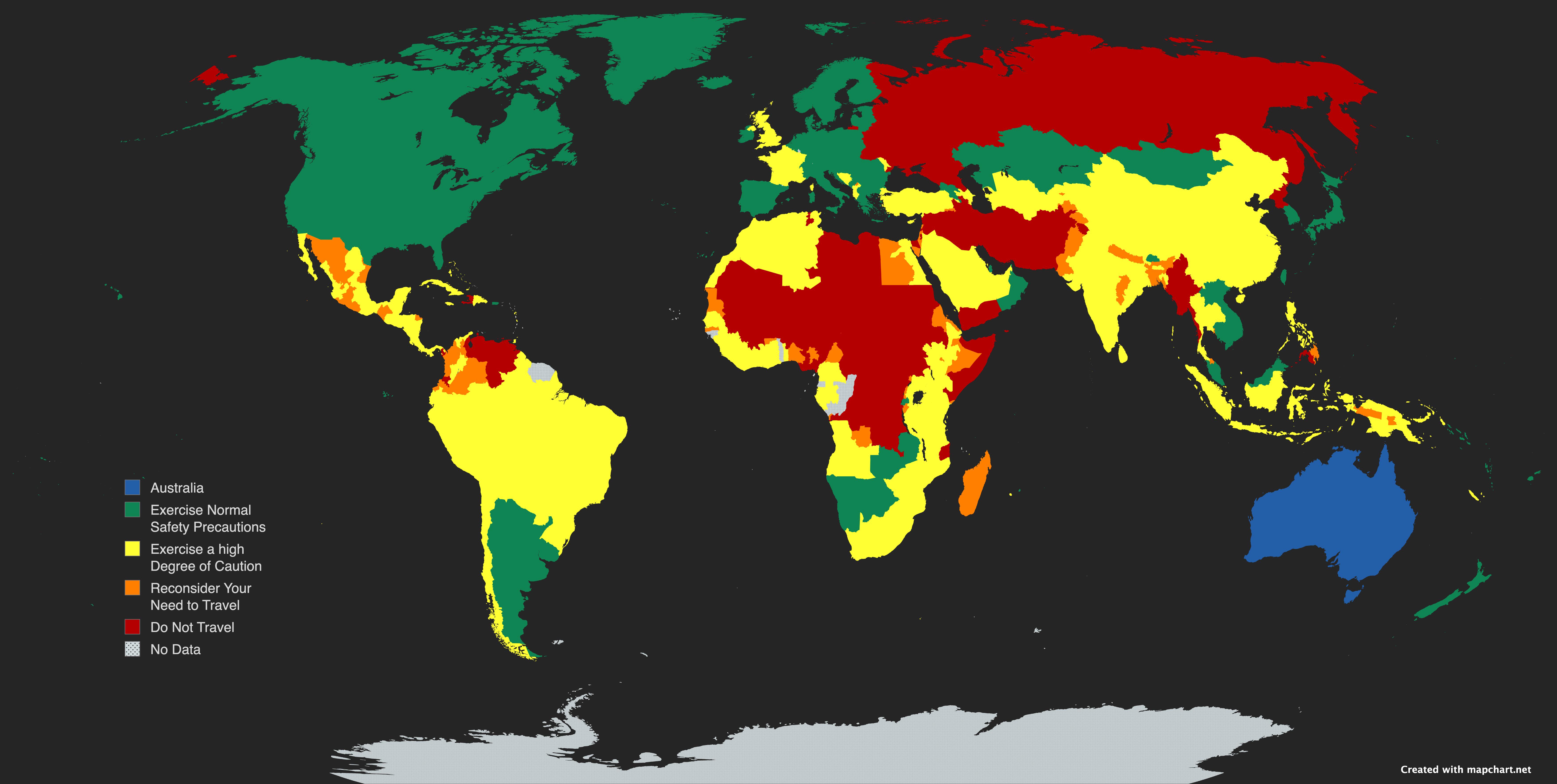Travel Advice Map by Australian Government


Alex Cartwright
Senior Cartographer & GIS Specialist
Alex Cartwright is a renowned cartographer and geographic information systems specialist with over 15 years of experience in spatial analysis and data...
Geographic Analysis
What This Map Shows
This visualization presents travel advisories issued by the Australian Government, focusing on subdivisions around the globe. Each country is categorized based on the safety levels recommended for their subdivisions, which can range from low to high risk. The map categorizes areas into color-coded levels: green for safe, yellow for exercise caution, orange for reconsidering travel, and red indicating do not travel. It's crucial to understand that some countries may have subdivisions with varying advisory levels, thus the overall classification may only reflect the majority. For instance, Nepal and Madagascar recently shifted from yellow to orange, signaling increased caution in these regions.
Deep Dive into Travel Safety
Travel safety is a multifaceted issue that encompasses various factors, including political stability, crime rates, health risks, and natural disasters. The Australian Government, through its Smartraveller website, aims to provide citizens with up-to-date information to help them make informed decisions about international travel. Understanding these levels is paramount for travelers. For example, a subdivision marked in red indicates significant risks, such as ongoing conflict or severe health threats. This might include areas like parts of Syria or the Democratic Republic of Congo, where the situation can be unpredictable.
Interestingly, the advisories are not static; they change based on the evolving conditions in a given region. For instance, the recent shift of Lebanon from red to orange suggests an improvement in safety conditions, although travelers should remain vigilant. Likewise, the border areas of Thailand and Cambodia have seen a downgrading from orange to red, indicating heightened risks possibly due to increased tensions or crime rates in those specific localities.
The rationale behind these advisories is to ensure that travelers are aware of the potential risks before embarking on their journeys. Factors such as local laws, cultural norms, and health advisories play a significant role in shaping these warnings. For example, the World Health Organization may issue health warnings related to diseases like COVID-19 or malaria, which can influence travel advisories. Moreover, natural disasters can prompt sudden changes in travel advice as well, particularly in regions prone to earthquakes or hurricanes.
Regional Analysis
When we look at specific regions highlighted in the map, we can see distinct patterns emerging. For instance, South Asia, represented by countries like Nepal, has seen a shift in its travel advisory levels. The transition from yellow to orange indicates a rising concern about safety, possibly due to political instability or natural disasters such as earthquakes. Comparatively, the Southeast Asian nations, particularly around the Thailand-Cambodia border, have also been marked with caution, underscoring the need for travelers to be alert in these popular tourist destinations.
In contrast, regions like West Papua have experienced a downgrade in their advisory levels, where areas previously marked orange have shifted to yellow, suggesting a relative improvement in safety. This can be attributed to various factors including governmental efforts to stabilize the region or improved local conditions.
Interestingly, the situation in the Middle East remains complex. Countries like Lebanon and parts of Syria often see fluctuating advisory levels due to ongoing socio-political challenges. While Lebanon's recent shift to orange is a positive sign, it’s essential for travelers to remain aware of the underlying tensions that might still exist.
Significance and Impact
Understanding travel advisories is crucial not just for individual travelers, but for the tourism industry as a whole. These advisories can significantly impact travel decisions, shaping the flow of tourists to various regions. For instance, a downgrade to red can lead to decreased tourism, which can adversely affect local economies that rely on visitor spending.
Moreover, these advisories reflect broader geopolitical and environmental trends. As global issues such as climate change, health pandemics, and political instability continue to evolve, so too will the travel advisories. Travelers must stay informed and proactive, utilizing resources like the Smartraveller website to ensure they have the latest information at their fingertips.
Ultimately, this travel advice map serves as a vital tool for anyone planning international travel. By understanding the implications of the advisory levels, travelers can make more informed choices about their destinations, ensuring safety and enjoyment on their journeys. Have you noticed how certain regions seem to fluctuate more often in their travel advisories? It’s a testament to the dynamic nature of geopolitics and global health that affects all of us in the world of travel.
Visualization Details
- Published
- October 21, 2025
- Views
- 16
Comments
Loading comments...